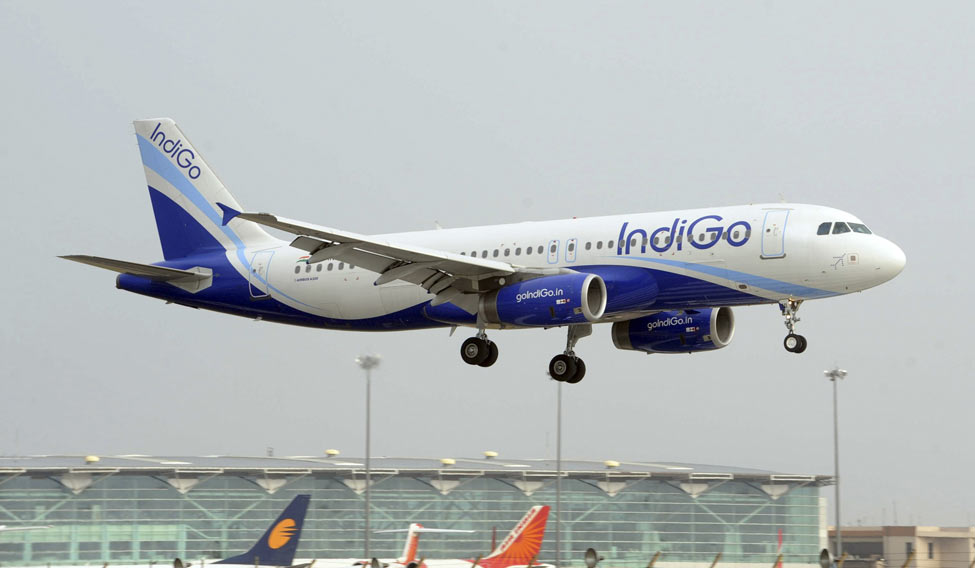Interglobe Aviation, the promoter of India's largest airline, just reported its highest ever quarterly profit for the three months ended June 30. The low cost airline's net profit jumped 37 per cent year-on-year to Rs 811 crore in the first quarter, much ahead of analysts expectations.
Indigo's revenue in April-June rose 26 per cent to Rs 5,955 crore.
Indigo's strong performance comes even as others have struggled. While, its listed peers, Jet Airways and SpiceJet, are yet to announce their quarterly numbers, earnings for the year, ended in March 2017, show Indigo's profit and revenue was far ahead of its rivals. In fact, its net profit was almost four times higher than that reported by SpiceJet and Jet Airways, even though Jet Airways reported slightly higher revenue.
Analysts say the airlines strong performance was predominantly driven by higher yields.
“Passenger revenues increased driven by a 25.4 per cent in RPK (revenue passenger kilometers) and 1.9 per cent increase in passenger yields (measure of average fare paid per km per passenger),” said Ashutosh Somani, analyst at JM Financial Institutional Securities.
Its RASK (revenue per available seat) also improved around 6 per cent, which boosted overall growth.
The airline's load factor rose by 470 bps to 88 per cent, which pushed up yields by 200 bps and does driving operational margins.
Acquiring newer A320neo planes, which are more fuel efficient has also helped.
“Fuel cost per ASKM (available seat kilometers) increased 8 per cent (in Q1), as compared to the average aviation turbine fuel price hike of 16 per cent during the quarter. This was owing to savings from fuel-efficient A320neos and other sourcing benefits,” said Vishal Rampuria of HDFC Securities.
IndiGo's strong performance is not just one-off. It has been one of the most consistent in terms of profitability in India's aviation sector over the years. One of the reasons is stringent cost management. The airline, for instance, operated just one type of aircraft—the Airbus A320, unlike multiple aircraft types that other airlines operate.
Also a majority of its aircraft were leased and not owned, which didn't pinch the pockets and also helped the airline get more technologically advanced aircraft in its fleet quickly.
Currently it operates 136 Airbus A320s and commands a market share of 41 per cent in the domestic market, up from 32 per cent in the first quarter of fiscal 2014-15.
Significantly adding more capacity has boosted its market share, which has come at the expense of rivals losing theirs. Jet Airways market share, for instance, dipped to little under 18 per cent from 21 per cent, state-owned Air India's share came down to 12.8 per cent from 17.4 per cent, according to analysts at Motilal Oswal. SpiceJet too has seen its market share come down slightly over the period.
CAPA, the global aviation consultants, note that IndiGo has the largest in-service fleet in India. Its order book is also largest of any airlines in the world, at 458 aircraft.
“Its fleet could expand by up to 46 aircraft during this financial year—a net addition of almost one aircraft a week,” it said recently.
The airline may have been flying high so far, there may be some headwinds ahead.
On Monday, in a post earnings analysts call, Rohit Phillip, Interglobe Aviation's chief financial officer, made a surprise announcement that it would slowly start buying and owning planes, unlike its focus so far on the sale and lease back model.
The airline has started getting deliveries of the new generation A320neo air craft, which while delivering 15 per cent more fuel efficiency, have lower risk of becoming technologically obsolete. So, these aircraft could be operated for a longer period than the average six year period it has so far used its planes, said Phillip, adding that buying planes over time would reduce ownership costs.
However, analysts say these will also put pressure on cash flows and so may be seen as RoE (return on equity) dilutive by investors.
“Change in ownership model of aircrafts will be fair value neutral as and when implemented, though it may bring free cash flow/dividends under pressure going forward,” said JM Financial's Somani.
Furthermore, the airline has also cut its capacity guidance (ASK) to 20 per cent from 25 per cent for the current fiscal year-ending March 31, 2018. This is because nine of its new A320 neos are grounded due to technical issues with the A320neo engines supplied by Pratt & Whitney. The engine issues are delaying deliveries of new planes to IndiGo as well as other airlines.
“While we do get some compensation for the grounding, operational disruptions are quite challenging and we aren't happy with that situation,” said Aditya Ghosh, president.
According to IndiGo, the engine issue is only expected to be resolved by late 2018 or early 2019 and in the interim, it is working to secure additional spare engines to reduce operational disruptions.
Due to the lower capacity addition guidance, analysts have cut earnings estimates on IndiGo by 2-3 per cent.
It is also diversifying its fleet. Earlier this year, the airline also announced plans to start regional operations by the end of this year, for which it will buy a fleet of 50 ATR aircraft, which CAPA says will only add to the complexity of its operations.
“Despite IndiGo's market-leading performance to date, this scorching pace (new plane additions) will undoubtedly test the capabilities of its management team, increasing the risk of negative impact on the airline's profitability and operational performance,” said CAPA.
Aviation industry earnings in FY 17






